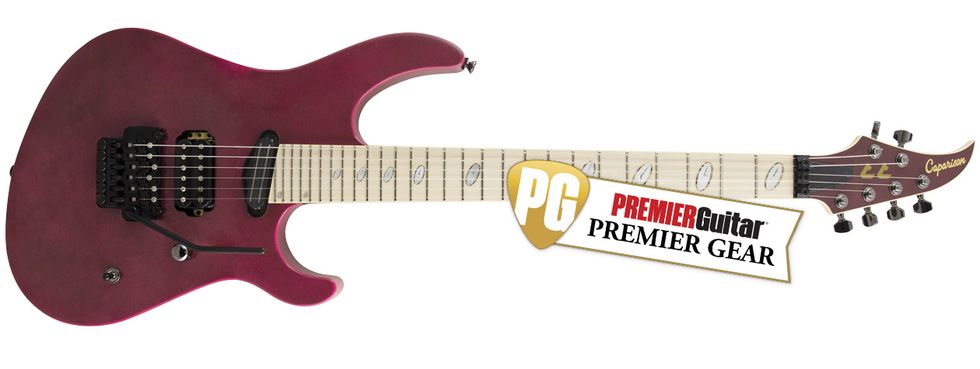RatingsPros:Excellent craftsmanship and playability. Cons: Expensive. Some might want a tone control. Street: $2,799 Caparison Horus-M3 CC caparisonguitars.com | Tones: Playability: Build/Design: Value: |
Caparison Guitars is, at this point, sort of an elder statesman among high-end metal guitar makers. Founded in 1995 by ex-staffers from Charvel/Jackson’s Japan division, Caparison was bought by a British company in 2011 and is now owned by George and Gabriel Ösztreicher. But original founder and designer Itaru Kanno is still onboard—personally inspecting and setting up every guitar before shipping.
Caparison builds weapons of choice for Killswitch Engage and Mattias Eklundh. And now their artist roster includes Courtney Cox of the Iron Maidens, whose namesake instrument, the Horus-M3 CC, is reviewed here.
’80s Excess
The CC’s body is built with a maple middle section sandwiched between mahogany wings. Our guitar came in an arresting pink sapphire finish that, combined with Caparison’s signature “Devil’s Tail” headstock and the fretboard’s clock inlays, elevates the guitar’s already ample ’80s-shred-machine aura.
Premium parts are used throughout the CC, including a CTS master volume knob, a Switchcraft 3-way pickup selector switch, a Schaller locking nut, and Gotoh tuners. The guitar is strung with DR Veritas strings (.009-.042) and comes with a shock-absorbent, semi-soft Reunion Blues Voyager case.
The guitar’s Schaller floating tremolo is a nice piece of hardware, too. It has a FU-Tone brass block for added mass, FU-Tone Titanium string lock insert blocks, and stainless steel saddle-mounting screws. It’s a light-yet-solid-feeling tremolo, with easy-to-maneuver fine tuners that have great sensitivity and range. You get all the dive-bombing ability you’d expect, but the tremolo is set from the factory for extreme pitch-up maneuvers, too. On the 3rd string, I was able to pull up a perfect fourth to C, and could almost make it to C#!
Perfect Harmony
Elsewhere, the Horus-M3 CC’s construction is excellent. Fretwork and the factory setup are both superb. The only minor issue I noted, a cosmetic one, was slight unevenness in the paintwork in the tremolo’s top recessed cavity. (Although it’s possible it may have been done intentionally as a design element.)
The 5-piece, maple-and-walnut bolt-on neck is not as thin as those you see on many shred machines, but it’s very comfortable. It features a maple fretboard with a 14"–16" compound radius and 27 jumbo nickel silver frets that give you access to two full octaves and then some. The oil finish on the neck provides a slick, fast feel that makes shredding easy. Having access to so much fretting real estate is a lot of fun. I have an old Washburn EC36 with access to 36 frets, so I’m familiar with the tiny space between frets that high up, but if you’re coming from the conventional 21-to-24-fret layout, the tight quarters might take some time to get used to.
Playing in the upper stratosphere of the CC reminded me that while extreme upper-fret ranges are sometimes considered a novelty by the uninitiated, they are ripe with musical potential when used judiciously. Of course, to make extra-high fretting work, playability is a must, and I was amazed that the absolute highest note on the guitar rang true and sustained easily. I was even more surprised that I could bend up a step-and-a-half on that note without fretting out. Impressive.
The neck joint heel cutaway allows access to the 27th fret, but, realistically, at the highest part of the fretboard it was most playable on the high E through G strings. From the D string down to the low E string, it’s hard to get a comfortable angle without weird fretting-hand contortions.
Flight of the Horus
I tested the Horus-M3 CC through Mesa/Boogie Tremoverb and Fender Prosonic amps. The Caparison pickups—SH-27F blade humbucker in the neck and PH-bc humbucker in the bridge—deliver distinctly classic metal colors that also manage to be a refreshing change from the sound of active pickups so prominent in modern metal. The neck pickup is quiet, exceptionally clear, and is free of the woofy qualities that plague some high gain neck pickups. The bridge pickup is tight and crunchy, and lends itself to chugging riffs like the intro to Iron Maiden’s “22 Acacia Avenue” and singing harmony melodies like the riff to “Aces High.” Interestingly, the sonic differences and volume ranges between the three pickup positions are not worlds apart in some high-gain settings. The upside is that changing between the three positions delivers very organic shifts in tone color.
There’s no tone control on the Horus-M3 CC, but—while having one would increase the guitar’s versatility—the instrument’s signature sound is very balanced, in general. The highs are not shrill or grating, and there’s a lot of tonal variation available just from manipulating the volume control. Knocking the guitar volume down to 8 tames high-gain tones noticeably. Down at 6, you can go from clean to dirty by varying your pick attack.
The Verdict
With a price tag of $2,799, the Horus-M3 CC is a splurge. But there’s no question that the Horus-M3 CC’s impressive build quality and surprising tonal range will justify the cost for many metal-in-the-veins players.









![Rig Rundown: Russian Circles’ Mike Sullivan [2025]](https://www.premierguitar.com/media-library/youtube.jpg?id=62303631&width=1245&height=700&quality=70&coordinates=0%2C0%2C0%2C0)

















